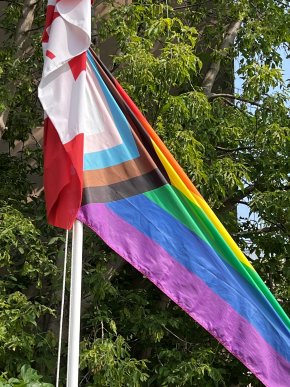Celebrating Pride in long-term care | Supporting LGBTQ2+ communities all year long
Amy, a social worker from one of our Greater Toronto Area (GTA) homes, recently spoke with us about what it means to be a strong advocate for inclusion and diversity (all year long) in her community.
The evidence of her impact is visible across our Extendicare homes in the GTA.
Open and proud year-round
Year-round, at Amy’s home, team members proudly wear rainbow lanyards and pins. There’s a rainbow-inspired sign at the entrance that sets a tone of inclusion. And residents embrace Pride month in June with book clubs, movie nights, meals and social events featuring the talents of the LGBTQ community. One of the highlights planned for this year at Amy’s home is a drag show.
“We have a very large staff complement that are open and out,” Amy says. “When we first started Pride Month movies, there was some hesitance from a small number of people. But many residents attended, and we received positive feedback and continue to host them.”
‘Back in the closet’: A reality for many seniors
While Canada decriminalized homosexuality in 1969, added “sexual orientation” to the Human Rights Act in 1996, and legalized same-sex marriage in 2005, Amy confirms – as research suggests – that sadly many seniors go “back into the closet” when they enter long-term care, fearing discrimination.
One resident confided in her that he and about ten other LGBTQ residents had quietly formed a social group where they could be their authentic selves. “He told me: ‘They won’t tell you who they are, but we talk, we talk in private.’”
In her role, Amy uses her pride and asserts her advocacy to help to navigate situations of LGBTQ discrimination. Amy recalled a few examples including a female resident who was uncomfortable having a lesbian roommate, and families who didn’t want their loved one cared for by an openly gay team member.
A safe space for everyone
Situations like this, Amy notes, show how important it is to visibly “fly the Pride flag” – literally during June and year-round with in their actions and visible signs of support.
“It’s about creating a safe space for everyone at the home,” Amy explains. “It sends a message to those who might be scared to come to long-term care. It also sends a message that we don’t tolerate discrimination for residents, families, visitors, or staff.”
Whether at work or in the broader community, Amy says that ongoing conversations are the first step in breaking down barriers to discrimination. “I make a point to put up a Pride flag, not for me, but for everyone who might be afraid to or feels invisible. I’m proud to be part of an organization where people ask questions, rather than create a ‘don’t ask don’t tell’ culture.”

